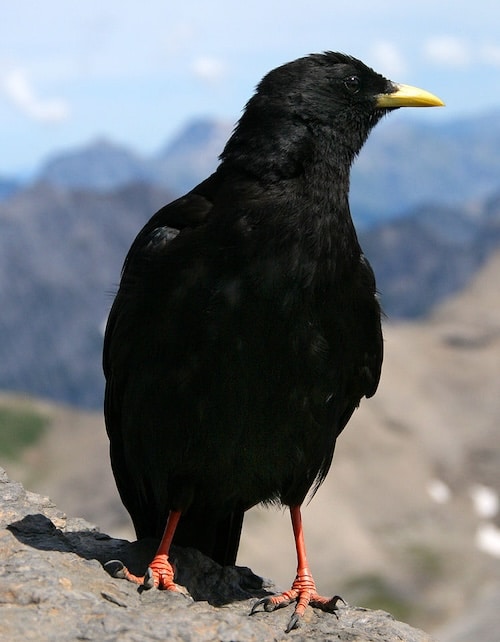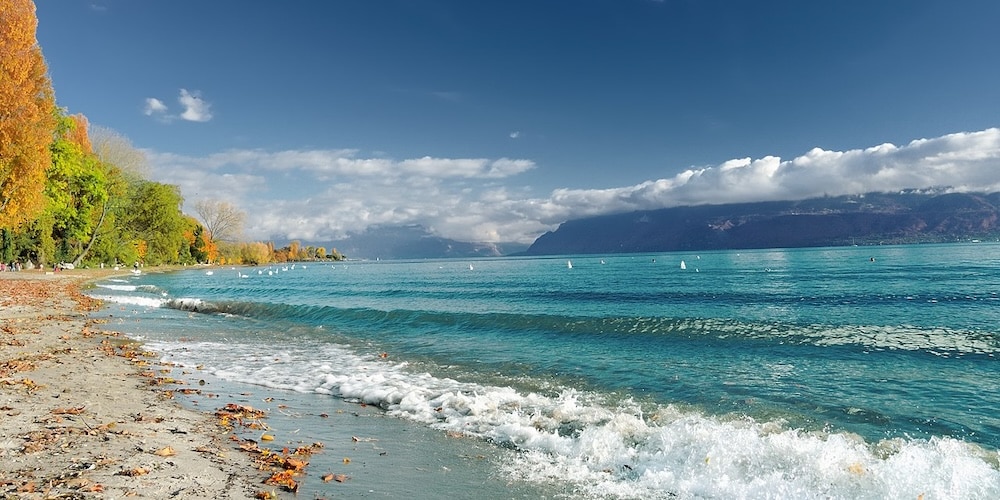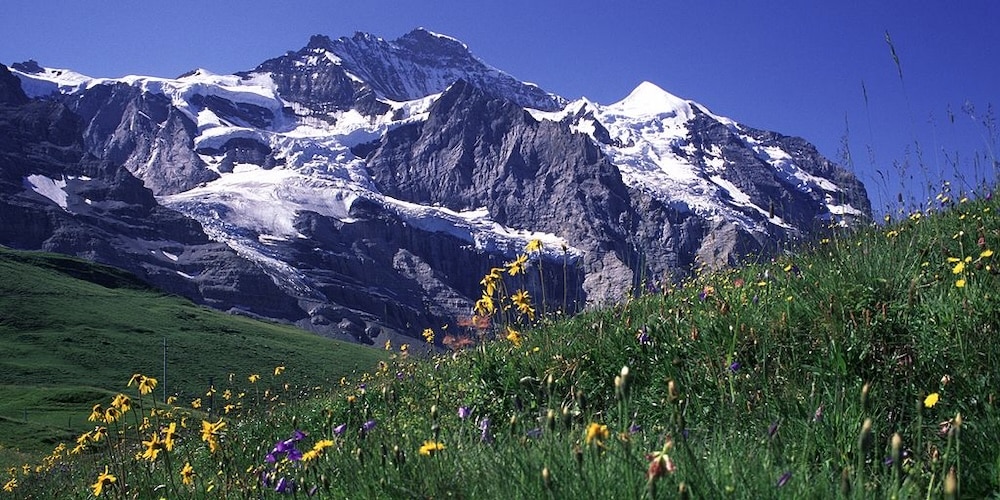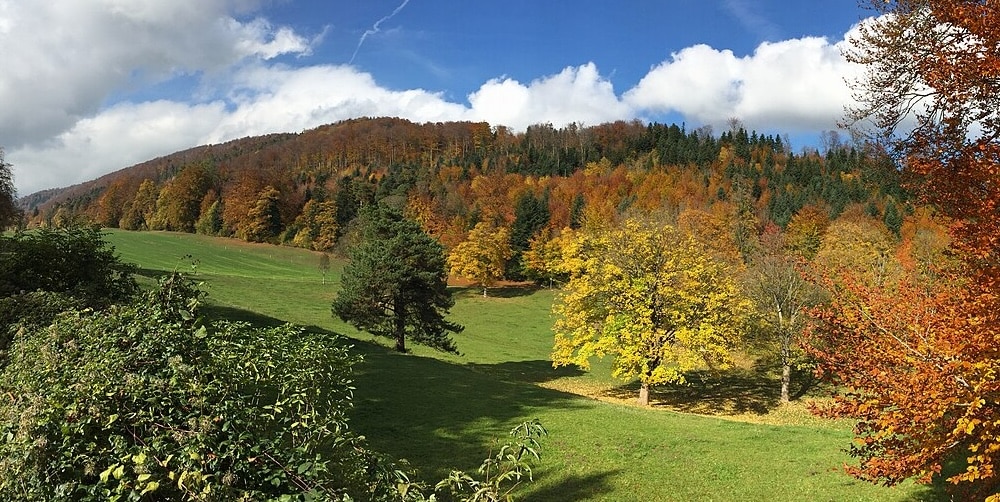Swiss Confederation

Switzerland is a landlocked country located in west-central Europe. It is bordered by Italy to the south, France to the west, Germany to the north, and Austria and Liechtenstein to the east. It is geographically divided among the Swiss Plateau, the Alps and the Jura; the Alps occupy the greater part of the territory, whereas most of the country’s over 9 million people are concentrated on the plateau, which hosts its largest cities and economic centres, including Zurich, Geneva, and Lausanne. Switzerland is a federal republic composed of 26 cantons, with federal authorities based in the capital Bern, although its largest city is Zurich the metropolitan area has around 1.5 million inhabitants, three times as many as Bern. It has four main linguistic and cultural regions: German, French, Italian and Romansh. Although most Swiss are German-speaking, national identity is fairly cohesive, being rooted in a common historical background, shared values such as federalism and direct democracy and Alpine symbolism. The country contains two small enclaves: Büsingen belongs to Germany and Campione d’Italia belonging to Italy.
Extending across the north and south side of the Alps, Switzerland encompasses diverse landscapes and climates across its 41,285 km2 (15,940 square miles). The Alps are a mountain range running across the central and south of the country, constituting about 60% of the country’s area. Here are the headwaters of several major rivers, such as the Rhine, Inn, Ticino and Rhône, which flow in the four cardinal directions, spreading across Europe.

Lake Geneva – ©Zacharie Grossen CC BY-SA 4.0 via Wikimedia Commons
The hydrographic network includes several of the largest bodies of fresh water in Central and Western Europe, among which are Lake Geneva, Lake Constance (Bodensee in German) and Lake Maggiore. Switzerland has more than 1500 lakes and contains 6% of Europe’s freshwater stock. Lakes and glaciers cover about 6% of the national territory. Lake Geneva is the largest lake and is shared with France. The Rhône is both the main source and outflow of Lake Geneva. Lake Constance is the second largest and, like Lake Geneva, an intermediate step by the Rhine at the border with Austria and Germany. While the Rhône flows into the Mediterranean Sea at the French Camargue region and the Rhine flows into the North Sea at Rotterdam, about 1,000 kilometres (620 miles) apart, both springs are only about 22 kilometres (14 miles) apart in the Swiss Alps. 90% of Switzerland’s 65,000-kilometre-long network of rivers and streams have been straightened, dammed, canalized or channelled underground, in an effort to prevent natural disasters such as flooding, landslides, and avalanches.

Jungfrau – ©Peter Alder CC BY-SA 3.0 via Wikimedia Commons
Forty-eight mountains are 13,000 feet or higher – at 15,203 feet, Monte Rosa is the highest, although the Matterhorn at 14,692 feet is the best known. Both are located within the Pennine Alps in the canton of Valais, on the border with Italy. The section of the Bernese Alps above the deep glacial Lauterbrunnen valley, containing 72 waterfalls, is well known for the Jungfrau, Eiger and Mönch peaks, and its many picturesque valleys. In the southeast is the long Engadin Valley, encompassing St. Moritz.
The Swiss Plateau, with its large lakes and cities, has greater open and hilly landscapes, partly forested, partly open pastures, usually with grazing herds or vegetable and fruit fields, but it is still hilly.
The Swiss climate is generally temperate, but can vary greatly across localities, from glacial conditions on the mountaintops to the near-Mediterranean climate at Switzerland’s southern tip. Some valley areas in the southern part of Switzerland offer cold-hardy palm trees. Summers tend to be warm and humid at times with periodic rainfall, ideal for pastures/grazing. The less humid winters in the mountains may see weeks-long intervals of stable conditions. At the same time, the lower lands tend to suffer from inversion during such periods, hiding the sun.

Forest, Jura Mountains – ©Yann Vitasse CC BY-SA 3.0 via Wikimedia Commons
Switzerland contains two terrestrial ecoregions: Western European broadleaf forests and Alps conifer and mixed forests. Switzerland’s many small valleys separated by high mountains often host unique ecologies. The mountainous regions themselves offer a rich range of plants not found at other altitudes.
Birding Switzerland
Switzerland may be small, but it is a very varied land and has much more to offer than its famous cheeses, cuckoo clocks and good Swiss chocolate. The most important Swiss cities are Berne, Zurich and Geneva; Berne as the capital, Zurich because it is the largest and most economically important city and Geneva for its international importance as the main seat in Europe of the UNO for example.
Switzerland has stunning landscapes. The well-known Swiss Alps, with the Matterhorn in pride of place, are especially magnificent. Equally beautiful, in their own right, are the myriad lakes of all sizes, and the rivers and streams, which are often to be found in literally fairy-tale surroundings.
From an ornithological point of view the Swiss Alps are of particular interest as almost all European mountain species are represented. In addition, they present migrating birds with a formidable obstacle and thus channelling them into particular routes. Many mountain passes offer superb vantage points for observing migrant birds. Large areas of the former wide-ranging moor land areas have sadly disappeared due to drainage out and adjacent agricultural use. Many breeding birds have as a result almost completely vanished. Nonetheless the Swiss wetlands remain interesting above all for the passage of migrating species.

Ponts-de-Martel, Pesatbog – ©Gab01, Public domain, via Wikimedia Commons
What Switzerland misses most is a coastline. For this reason, all typical sea and coastal birds are rarely, if ever, seen.
-
Number of bird species: 443
(As at April 2025)
-
Avibase
PDF ChecklistThis checklist includes all bird species found in Switzerland , based on the best information available at this time. It is based on a wide variety of sources that I collated over many years. I am pleased to offer these checklists as a service to birdwatchers. If you find any error, please do not hesitate to report them. -
E-Bird
PDF ChecklistThis checklist is generated with data from eBird (ebird.org), a global database of bird sightings from birders like you. If you enjoy this checklist, please consider contributing your sightings to eBird. It is 100% free to take part, and your observations will help support birders, researchers, and conservationists worldwide. -
Wikipedia
Annotated ListThe avifauna of Switzerland included a total of 443 species as of 2024 according to the Swiss Ornithological Institute (Schweizerische Vogelwarte) with supplemental additions from Avibase.[1] 10 have been introduced by humans.
-
Birds of Europe, North Africa, and the Middle East
| Photographic Guide | By Frédéric Jiguet & Aurélien Audevard | PUP | 2017 | Paperback | 447 pages, 2200 colour photos, colour distribution maps | ISBN: 9780691172439 Buy this book from NHBS.com -
Collins Bird Guide
| By Lars Svensson | Harper Collins | Edition 3 | 2023 | Paperback | 478 pages, 4000+ colour illustrations, 700 colour distribution maps | ISBN: 9780008547462 Buy this book from NHBS.com -
Where to watch birds in Switzerland
| By Marco Sacchi, Peter Ruegg & Jacques Laesser | Christopher Helm | 1999 | Paperback | 192 pages, B/w photos, line illustrations, maps | Out of Print | ISBN: 9780713651836 Buy this book from NHBS.com

Collins Bird Guide
AndroidThe Collins Bird Guide App provides everything you need to identify a species quickly and learn about it thoroughly.
Collins Bird Guide
Apple iOS |Collins Bird Guide 4+ A field guide to Europe NatureGuides Ltd. Designed for iPadObservatories-
The Sempach Observatory (Schweizerischen Vogelwarte Sempach)
Observatory WebsiteSatellite ViewThe homepage of the Swiss Observatory at Sempach, the largest private field research institute. Includes a quiz on Swiss birds, extensive information on Swiss species and a lot more besides. [Die Homepage der schweizerischen Vogelwarte Sempach, welche das gr
Museums & Universities-
Museo Cantonale di Storia Naturale
InformationNel 1854 Luigi Lavizzari, naturalista e uomo politico, creò presso il Liceo cantonale (allora nel centro di Lugano) un gabinetto di storia naturale con parte delle sue collezioni, nell`intento di gettare le basi per un futuro museo patrio…
Organisations-
Ala - Schweizerische Gesellschaft für Vogelkunde und Vogelschutz
WebsiteThe Swiss society for the protection and preservation of birds.Werner Holliger, Breitestr. 22, CH-5015 Niedererlinsbach, sekretariat@ala-schweiz.ch -
BirdLife Switzerland
WebsiteBirdLife Switzerland is active for the conservation of biodiversity in Switzerland and, through its partnership with BirdLife International, all over the world. BirdLife Switzerland has over 70,000 members and incorporates 20 national and cantonal associations as well as 430 local groups. -
Ficedula - Società pro avifauna della Svizzera italiana
WebsiteThe Swiss society for the protection and preservation of birds in Italian Switzerland. -
Nos Oiseaux - Societe Romande pour l`Etude et Ia Protection des Oiseaux
Website50 rue AchilleMerguin, CH-2900 Porrentuy. +41 6666 5629Nos Oiseaux est une soci -
Ornithologische Arbeitsgemeinschaft Graubünden
Webpage -
Pro Natura
WebsitePro Natura - Switzerlands Number One in Conservation - we provide nature reserves with in-the-field conservation in over 700 reserves all over the country; in agricultural, forest, urban and wilderness areas. Pro Natura was founded to create the only Swiss National Park in 1914 and has since helped to establish half of all protected areas in Switzerland. The creation and management of reserves is still one of the main tasks of Pro Natura. -
Swiss Ornithological Institute
WebsiteThe Swiss Ornithological Institute is a non-governmental scientific research institute at Sempach, near Lucerne. It was founded in 1924, mainly as a centre to organise and co-ordinate bird ringing in Switzerland and to study bird migration. Since 1954 the SOI has been a private foundation for ornithology, supported by donations and subscriptions from the Swiss population. It nowadays covers a wide range of topics from bird migration and ecology to population monitoring and applied studies for landscape management and conservation. -
Swiss Rarities Committe
InformationThe Swiss Rarities Committee is a group of independent experts who verify sightings of rare birds in Switzerland on a voluntary basis. The office is run by the Swiss Ornithological Institute.
Reserves-
*Protected areas of Switzerland
InformationSatellite ViewInteractive ;list of national parks, nature reserves etc... -
NP Parc National Suisse
WebsiteSatellite ViewHere you can obtain information about the only national park in Switzerland, its particularities and what it has to offer. Use the search machine to find the information you are looking for.
Sightings, News & Forums-
eBird
SightingseBirding This Month
Guides & Tour Operators-
NatureTrek
Tour OperatorAn 8-day holiday to the Swiss Alps in search of birds, as well as butterflies...
Trip Reports-
2018 [12 December] - Roland van der Vliet
PDF Report...My observations do give you an idea what can be seen. These include alpine species like Golden Eagle, Alpine Accentor, Lammergeier, Alpine Chough and Spotted Nutcracker. I searched for my WP nemesis bird, Three-toed Woodpecker, during both trips but again failed... Especially the December trip should have delivered, as I was certain I was in prime habitat under the guidance of local birder Hans Meierhans. I want to thank him for taking me out birding. I also want to thank Jan Bisschop for bringing us in contact... -
2019 [06 June] - Alps
PDF Report...From the train we saw out first butterflies, managing to spot Small Tortoiseshell, Large and Small Whites and Common Ringlets... -
2025 [03 March] - Fitzroy Rampersad
Report
Other Links-
Birds On-line
WebsiteMuch information on European birds, over 250 pictures, red lists, etc -
CH Club 300
WebsiteHere is information about the SMS-Rarities Service and news about rare birds in Switzerland (birdnames in german, french and english). There is also a ranking of the swiss birders -
Oiseaux
WebsiteObservation, -
Vogelbilder
WebsiteBirds and other pictures of nature
Blogs-
Birding in Switzerland an abroad
BLOGWelcome to my blog. I love a lot of things. There is wonderful nature with lots of animals that I like to take pictures of - I like to share them with you here
Photographers & Artists-
Photographer - Fotos freilebender V
GalleryBird photos from this Swiss bordering photographer -
Photographer - Michel Roggo
GalleryWelcome to Michel Roggo Online featuring the work of swiss wildlife photographer Michel Roggo. It contains two parts. The first For Editorial Use, is made especially for people looking for stories or photographs of nature and wildlife for commercial use. The fastest way to get some information about Michel Roggo and his work is to go to About Roggo. Stories features stories ready to edit in magazines, an there are Photographs of particular species, especially of fish, birds, and mammals. For a fast and up-to-date information about the photographs in the files, please go to Archive List, and you may as well print this list. -
Vogelfotos der Westpal
Gallery
Fatbirder - linking birders worldwide...
Skip to content
